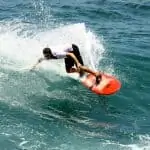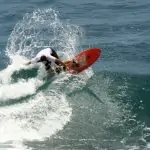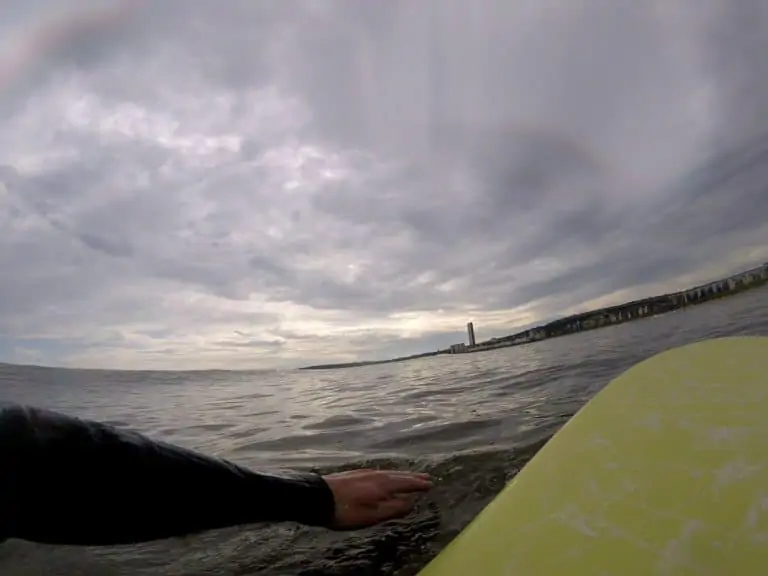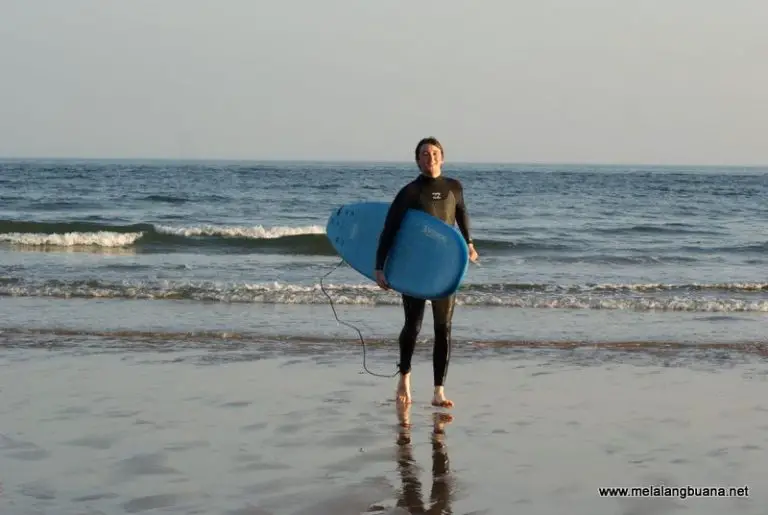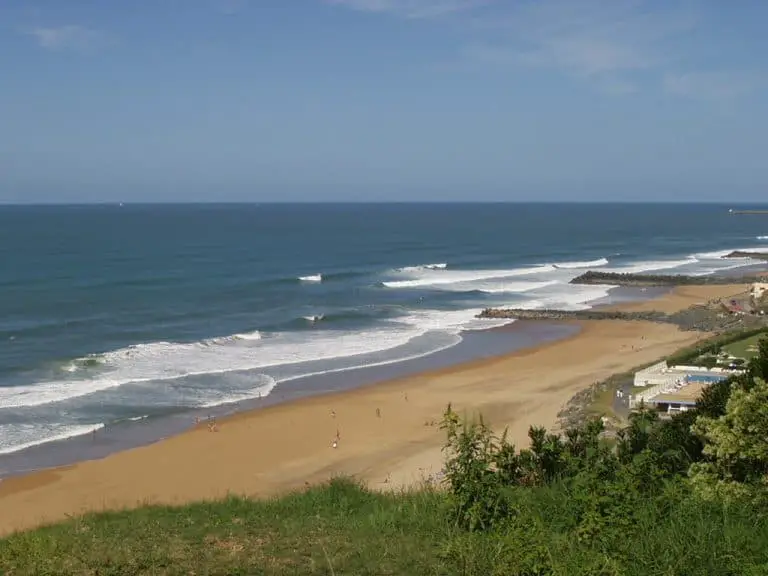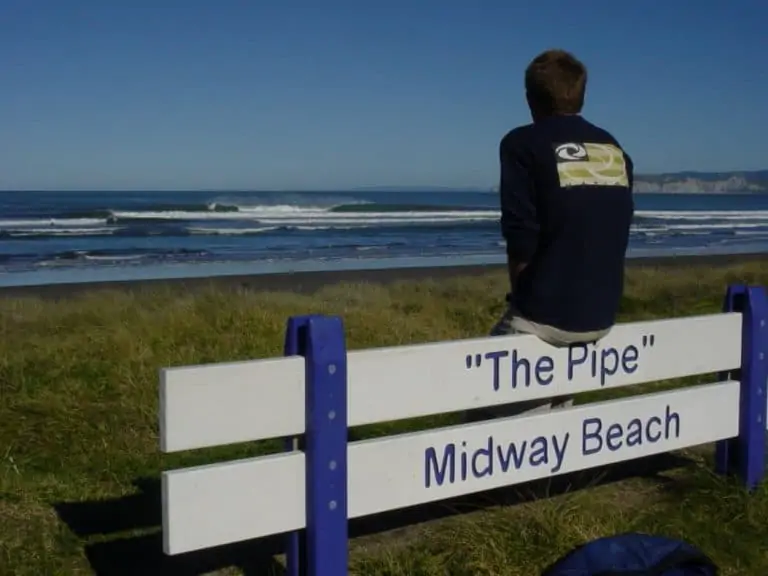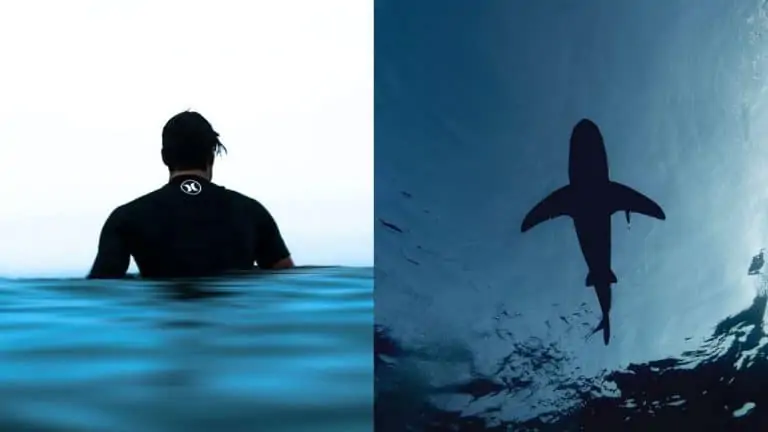Is Surfing Dangerous for Beginners? (Sometimes + Safety Tips)
Surfing is one of the best sports you can try. It will give you some of the best memories and have the most fun while doing it.
However, when starting out, there are a lot of questions you may have as to the safety of surfing and how to make it as safe as possible.
We’ve all seen the classic film, Jaws, and thought that surfers get attacked by sharks on a daily basis. Which, of course, we all know is not true.
It puts these kinds of fears into people, as well as other aspects we hear about learning to surf.
Is surfing dangerous for beginners?
Not really if you learn to surf in the proper way and do it safely because learning means staying close to shore in small waves. However, there are other dangers to consider, as I’ll explain in this post below.
Learning to surf properly and safely
If you learn to surf with a big surf board that is soft and is easy to paddle, then you will be able to learn to surf in the small waves in the shallows.
This means that you do not need to go far from shore and you can learn a heck of a lot in a very safe environment.
Key dangers of learning to surf
- Rip currents
- Other surfers
- Rocks and reefs
- Surfboards
- Sharks
Rip currents
I’ve put rip currents as the first on my list for surfer because they are a hidden danger but common. Now these are the currents that can take you out to sea or pull you down the beach.
You can have undertow but you can’t really see them unless you know what you’re looking for in the surf. Often a kind of choppy effect that looks a bit like a river mouth but only visible to the trained eye.
However, what you can do is to look at the signs on any beaches before you paddle out and go to the right surf spot and surf on an incoming tide. Now check out my detailed guide to the right time for surfing for more on that.
Generally speaking, the incoming tide, between low and high, after low and before high, has the fewest rips because of the way the tides move. If you go on an outgoing tide, it can have more rips, as detailed the post above.
Again, looking at signs at the beach will tell you if this beach is safe for surfing. Now signs about swimming is a bit different because swimmers don’t have a surf board.
So you can take those with a pinch of salt, but they do give you an idea of how it is out there in the surf. Also consult surf guides and websites, as they will tell you the best places to go surfing for a learner.
So choose your spot carefully, and the rip currents shouldn’t be an issue. There’s another point here that learning with other learners is always a good thing.
So if you see lots of surf schools at the beach, that is a good sign that this is a good learner surf spot and should likely have few currents.
If you can find somewhere with a lifeguard or surf rescue on patrol, then that’s also a good bet for safety.

Always learn to surf in a group, be it with your friends or just where there are other beginner surfers – not professionals, remember not good surfers, at least, other learners specifically.
Other surfers as a danger
Now, I’ve said above that learning to surf in a group with others is a good thing. You don’t want to be surfing in too tight a group with hundreds of others. It can make things a bit more difficult for you to learn properly.
Find a beach that has surf schools and other learners, but also that has that space. If you’re tightly packed in like sardines, that can actually be an issue since you can get in each other’s way.
If surfing at a busy spot is the only option for you, then check out my dedicated article on how to surf a crowded lineup here for more tips!
Again, where you need to be really careful is where other surfers are not learners. They will expect you to know the etiquette and rules. They will be surfing as normal with the expectation that you can get out of their way.
However, learning to surf takes a lot of time and actually getting out of people’s way is harder than it sounds. So don’t go in the surf if there are other surfers who are very high level or at least who look really good.

Photo Credit: Miguel A. Amutio on Unsplash
As an additional point, I would always recommend going for a surf lesson to start off your surfing journey as this will really help you. It will also give you an idea of all the equipment and techniques you need.
Just be aware that you don’t need to go for lots of surf lessons. Having one will give you a flying start and help you to speed up your time spent surfing.
You can check out my YouTube video on choosing a good surf school below to get more tips on this:
If you want an idea of how long it takes to surf, check out my detailed guide on that here.
Rocks and reefs
Rocks and reefs are another danger you need to be aware. As the tide comes up it can cover these and you might not see them. As a learner surfer, you should avoid rocks or reefs and surf a spot that has a sandy bottom.
So just a normal beach break wave as it’s called in surfing, and this is just a standard beach. You can see a low tide where there’s just sand and nothing else.
Clearly, falling on a rock after you fall off a wave or a surf board is not going to be nice. It will be painful and increases your risk of injury several times over.
The good news is that most learner surf spots are actually sandy bottomed. You don’t really need to worry about this but just keep an eye out. Have a look at the beach at low tide so you can survey things like rocks and reefs.
And if the surf guide says, “reef break,” then you should not be learning there. Even if there are surf schools, it is not a good idea because even things like standing up, you can cut your feet on the rocks.
Yes, you can buy reef booties specifically for this, but it’s just not a pleasant learning experience. Reefs and rocks should be much more advanced surfing, and that can come later.
If you hit your head on a rock out in the surf, you can be in trouble. This comes from things like not knowing how to fall off a wave, which you will learn as you improve and get better at surfing.
Surfboards
Now we’ve talked about other surfers, but specifically their surfboards can also be a real problem. They are big, hard objects and when someone is riding on them, they carry a lot of weight.
You’ve probably also seen that surfboards have a fin or multiple fins, these can be like a blade. I know of several people who’ve had severe head injuries, leading in some cases to being paralyzed for life.
And I say that as an extreme, but I do know people who have in this condition. Others who’ve been out of the surface six months because somebody on a surfboard ran them over, hit their head.
Now this is extremes but it does happen. You really want to get yourself a soft surfboard so that when you fall off, as you will a lot, you don’t hit others. You should be around others with soft or learner surfboards.
Again, choosing your spot and the place on the beach that you choose to paddle out is crucial here. It will make it safer and reduce that danger for you and others around you.
You will need a good strong leash as well to make sure that your board doesn’t fly off and float into the beach with the wave you catch and fall off on. This will stop it hitting others as well.
Although, a leash will be as long as the board, it will have a range that is twice the length of the board. Don’t get too close to others since it’s impossible to control your board when falling, so you need to consider that.
For these reasons, I always recommend learners to start with a soft-top leaner surfboard. It is because more forgiving when falling and if it hits someone else, it’s much softer for them.
These kinds of boards are designed for learners. They have the right shape and they float really well and help you to catch lots of waves. So I could not recommend them strongly enough.
I have one and I’ve surfed for over 20 years and it is just the most fun surfboard I have. So even then, it’s a great board to have. And they’re also that bit cheaper as well, making them more budget friendly.
If you want to see more, check my dedicated posts to best beginner surfboard brands, all of which have soft boards.
Sharks
I’ve put sharks bottom of the list because they deserve that place.We all think about sharks when we go out surfing and they are out there. We definitely need to be aware if we are surfing in sharky waters.
Statistically, they are not a concern. I know there are growing numbers of shark attacks on surfers around the world, but we still need to put this into context.
The amount of people who go into the sea every day around the world without any shark issues is incredible. Remember, it is the tiniest amount of people who have shark attacks and not something you should worry about.
Much more dangerous is driving a car on the road, or just about doing anything in an urban area outdoors. I can’t say it enough that you shouldn’t worry about sharks.
Check out my article below on surfing and sharks if you are concerned and want more information on this topic:
But just to be aware, surfing at times like dawn and dusk is a time for increased shark feeding activity. Also, surfing on your own may increase these chances as well.
If you surf far out to shore, which you should only do as an advanced surfer, can also increase the chance of sharks being interested in you. But again, this seems a bit silly to say, because you don’t need to worry about it.
Educate yourself on the area and what happens. Think twice about surfing on your own in sharky areas and try to surf during the day, rather than the earliest or latest times.
That will then give you the best chance of avoiding any shark encounters. Of course, things do happen, but the chances of it are so slim, it’s not really worth worrying about.
How far out do you paddle to surf?
You paddle out as far as the waves need. This could be anything from five yards to 100 yards depending on your chosen spot but most learner spots should be within about 20 to 30 yards of shore.
You might not even need to paddle if you are learning to surf, as you could do most of it in the shallows.
Swimming and learning to surf
You do need to be able to swim to learn to surf, but you don’t need to be an Olympic swimmer. You really just need to be able to do the basic swimming, and it’s also great for your fitness and confidence as well.
Be sure to go in the pool a few times before learning to surf for the first time if you can, but if you learn in a surf lesson, you don’t really need much in the way of swimming ability.
However, if you want to surf on your own, then I would recommend improving your swimming technique and fitness.
What are the rules in surfing?
Surf at spots that suit your level. Be courteous, wait for a wave, don’t cut others up. Be safe when you catch a wave, don’t ride too close to others and just be respectful in general.
Those are the main rules of surfing etiquette and if you follow them, you should not have a problem.
I think the main problem is paddling out at the wrong spots, expecting to catch waves and just carry on. Do not do this, it is dangerous. You might hurt others and yourself, you will not be welcomed back there in future.
So take your time, pick your spots carefully, and follow the rules and you should be okay.


